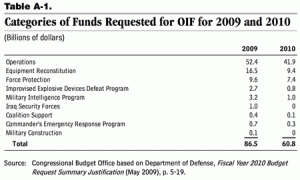
One of the major budgetary challenges for 2010 and 2011 will be providing for the withdrawal of US forces from Iraq and the training and support for Iraqi security forces. These costs will be variable, notably they depend upon events and are subject to ruptures in the process. These costs include infrastructure construction, clean-up of bases and weapons, turnover or transfer of weapons to the Iraqis, some of which will be done through Foreign Military Sales, and, of course, training and partnering with Iraqi forces can slow down significantly the full withdrawal of US forces from Iraq. And if there are significant events in the region affecting Iraq, the US could well be held hostage to developments and will have to fund and support forces in the region.
The Special Inspector General for Iraq Reconstruction (SIGIR) captures some of these costs in its regular reports, but given that this SIGIR has been set up as a watchdog for fraud, waste and abuse of funds, its reports will only capture some of the costs (http://www.sigir.mil/). Even so, the costs are in the tens of billions of dollars in the view of SIGIR.
And Congressional Budget Office estimates, which have focused more directly on the costs of withdrawing US forces, underestimate the costs of the transition from US surge and presence to partnering and support (http://www.cbo.gov/ftpdocs/105xx/doc10523/10-07-TierneyTroopWithdrawal.pdf)
What this slide show features are some of the varied activities involved in the Iraq transition.
[slidepress gallery=’withdrawal-from-iraq’]
The first photo shows Sgt. 1st Class Antonio Jurilla, Port of Entry Transition Team operations assessing operational readiness of border police located at the Al Sheeb PoE in southern Maysan province. The PoETT is attached to 4th Brigade, 1st Armored Division and spearheads the “advise and assist” mission along the Iraq-Iran border (credit Multi-National Division-South 12/16/09).
The second photo shows U.S. soldiers, assigned to 1434th Engineer Company, with members of the Iraqi Army, hoisting a truss with a crane, at 4th Brigade, 2nd Battalion Infantry Division’s Joint Operation Center, Forward Operating Base Constitution, Baghdad, Iraq, Dec. 15. Together the U.S. Soldiers and members of the Iraqi Army work to build a 40×60 division level Tactical Operation Center. (credit Joint Combat Camera Center Iraq).
The third photo shows efforts to build the Iraqi Navy. The Coalition Naval Advisory Training Team here has been mentoring and training units of the Iraqi Navy and Marines for more than three years.Comprised of nearly 150 active and reserve Sailors and Marines, the International Transition and Advisory Mission combines United States and United Kingdom trainers to help guide the development of the Iraqi Navy.This partnership continues to enhance the Iraqi Navy’s ability to provide protection of its territorial waters, oil platforms and maritime infrastructure. (credit US Naval Forces Central Command).
The fourth photo shows U.S. Blackhawks landing at Umm Qasr’s landing strip on Nov. 15 with UK troops and equipment as part of the Iraqi Training and Advisory Mission with their U.S. allies. Over 75 UK service members will be training the Iraqi navy alongside their U.S. allies as part of the mission that runs through 2011. (credit 203rd Public Affairs Detachment).
The fifth photo shows 4 Iraqi T6-A training aircraft conducting a flyby at the ground-breaking ceremony of the new air traffic control tower in Tikrit, Iraq. (credit Multi-National Security Transition Command Iraq Public Affairs, 12/17/09).
The sixth photo shows n Iraqi air force King Air 350 sits on the airfield at Al Muthana Air Base, Iraq, May 8. The airplane is assigned to the Iraqi air force’s King Air Squadron 87 and boasts the intelligence, surveillance and reconnaissance capabilities necessary for the detection and deterrence of insurgent activity. (credit US Air Force).
Photo 7 shows Staff Sgt. Joshua Roden advising his Iraqi counterpart during combat operations over Iraq May 8. They are flying aboard an RC-12 assigned to the Iraqi air force’s King Air Squadron 87. The airplane boasts the intelligence, surveillance and reconnaissance capabilities necessary for the detection and deterrence of insurgent activity. Sergeant Roden is a mission sensor operations instructor, assigned to the Combined Air Forces Training Team. (credit US Air Force).
Photo 8 shows U.S. Air Force instructors assigned to the 721st Air Expeditionary Advisory Squadron here along with their Iraqi students prepare to lift off in a Mi-17 helicopter on a mission using night vision goggles Oct. 7, 2009. U.S. Air Force instructor pilots assigned to the 721st AEAS train, advise and assist Iraqi helicopter pilots around the clock, helping the Iraqis develop their own air force. (credit U.S. Air Forces Central, Baghdad Media Outreach Team, 10/7/09).
Photo 9 shows Spc. Richard Muniz, a personal security detachment gunner for 15th Sustainment Brigade, 13th Sustainment Command (Expeditionary), watching the area during a mission to the Al Qayyarah water pump, in Al Qayyarah, Iraq, Dec. 1. (credit 15th Sustainment Brigade).
Photo 10 shows 1083rd Transportation Company Heavy Equipment Transport trailers sit loaded with 2nd Brigade Combat Team, 1st Cavalry Division, tanks, ready to be moved. (Credit 15th Sustainment Brigade, 12/10/09).
Photo 11 shows Col. Larry Phelps, 15th Sustainment Brigade, 13th Sustainment Command (Expeditionary), commander looking at the machinery in the pump house on the Tigris River at Al Qayyarah, Dec. 1, as his body guard, Staff Sgt. Stuart Gimble, a Washington, D.C., native and 15th’s personal security detachment platoon sergeant, watches from above. (credit 15th Sustainment Brigade).
Photo 12 shows shipping containers being loaded during preparation for a convoy logistics patrol, near Al Hillah province, Iraq, Dec. 13, 2009. The convoy brings supplies and equipment for U.S. Soldiers stationed at Stackhouse. (credit Joint Combat Camera Center Iraq).
Photo 13 shows U.S. Soldiers patrolling throughout the Ur area, north of Baghdad, during a presence patrol, Dec. 15. Although the unit is equipped with Mine-Resistant Ambush-Protected vehicles, Bradley Fighting Vehicles and M1A1 Abrams tanks, Soldiers used their feet to travel the streets during their most recent presence patrol.

According to Capt. John Ulsamer, commander of Company A, foot patrols are less intimidating, and the unit gets better cooperation from the local populace. Trekking through muddy streets, surrounded by local children, the Soldiers made contact with several townspeople, conducted impromptu vehicle searches and handed out flyers to children.The flyers informed children of the risks of carrying around toy guns and running around military convoys. 1st Lt. Nicholas Ramos, a platoon leader with Company A, said the safety of the children is just as important as ensuring the village’s overall security.”We just want [the Iraqi people] to know we are still here for them,” said Ramos, a Nokesville, Va., native who has been part of these patrols for over six months.The search was driven by a cache that exploded on the grounds of a school while the students were burning trash. School officials requested that the IA clear other schools in the area to ensure insurgents hadn’t hidden any additional caches. (credit Multi-National Division Baghdad).
———-
***Posted December 28th, 2009

